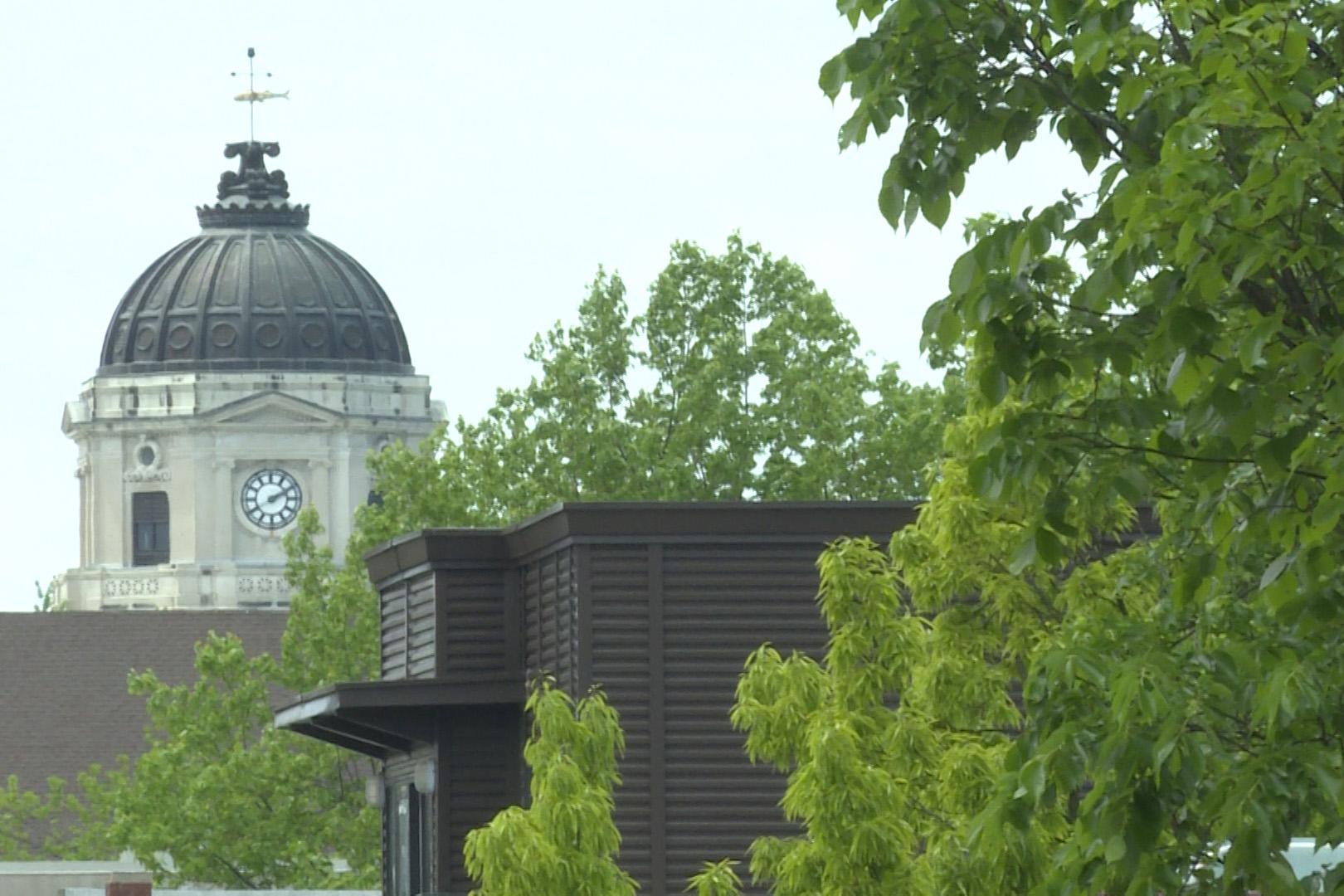
The waterfront by the White River in Indianapolis. (Doug Jaggers, WFYI)
For the 50th anniversary of Earth Day recently, Doug Spence produced 500 packets of wildflower seeds, including milkweed, to be handed out at a festival at White River State Park in Indianapolis.
Like everything else during the coronavirus outbreak, however, the event was canceled.
But he will continue to distribute milkweed, necessary for survival of the imperiled monarch butterfly, throughout the Midwest this year out of his native plant nursery, Spence Restoration Nursery, established 25 years ago.
The nursery produces about 50,000 milkweed plugs annually, plus hundreds of pounds of milkweed seeds, for planting in places such as toll road rights of way, underneath utility company high-voltage overhead power lines, and in low spots in city parks.
The seed production side of Spence’s business became more efficient this year after he spent the winter building a replica of a milkweed gin (“gin” is related to the word “engine”) patented in the 1930s by Dr. Boris Berkman of Chicago.
During World War II, milkweed gins in Petoskey, Mich., processed tons of milkweed “floss” — the white, fluffy hairs inside milkweed pods — as filler for U.S. military life preservers. Widespread milkweed pod collection drives were conducted by community organizations, school children (including those in the Muncie, area, according to Spence) and others to protect airmen and seamen from drowning.
Out of curiosity, Spence was researching milkweed gins online and stumbled across — on Google — Dr. Berkman’s patent, which was no longer protected. The machine is similar to the better-known cotton gin, which separates cotton fibers from their seeds.
The milkweed gin’s components include hopper, roller, beater paddle, screen, spinning drum, negative air chamber, cyclone and bag.
“This thing is made out of — you don’t buy any of these parts,” Spence said. “It’s made from other components that we had.”
Three local businesses —Keppler Steel, Thompson Welding and Fuller Architectural Hardwoods — helped fabricate the machine, which includes thermally modified yellow poplar.
Just like during WW II, milkweed pods still have to be hand-collected from acreage owned by the nursery and through agreements Spence has with other property owners.
But the gin will separate the milkweed seeds, the floss and the pods (a waste product plowed back into the ground). The seeds are used to either grow milkweed plugs in the greenhouse or packaged for sale with seeds of other flowers and grasses in a prairie or meadow mix. The floss is a potential source of hypoallergenic filler for pillows, comforters and jacket linings.
Up until now, Spence has been using mini combine harvesters to process the pods. While that machinery removes the seeds, it leaves the potentially marketable floss tangled up with the pods. And it requires three people to run a combine compared to one gin operator.
“With the demise of the monarch butterfly, there is increased demand for milkweed,” Spence said.
He cited as an example the Ohio Pollinator Habitat Initiative, which calls on Ohioans to collect milkweed pods. Started in 2015, the project has harvested thousands of pods across the state yielding millions of seeds.
Another example of milkweed’s appeal is that every time Spence’s wholesale nursery gets mentioned in a publication, it gets flooded with calls and visitors who want to make purchases, mistakenly thinking it is a retail store.
Backyard gardeners aren’t part of the nursery’s customer base. It supplies 180 species of native plants, primarily grasses, sedges and flowers, for installation on projects like restoration of wetlands along the Maumee and Cuyahoga rivers in Ohio to curb pollution runoff into Lake Erie.
“We average about 50,000 milkweed plugs a year, with swamp milkweed being the largest component due to the development of sedge meadows that include pollinator habitat on large public works projects or for (USDA) Conservation Reserve Programs for landowners,” Spence said. “Cities throughout the Midwest like Carmel, Indiana, use native vegetation swales, sedge meadows, and stormwater wetlands to meet their 401 Clean Water (Act) requirements.”
Indy Parks and Recreation, an example of another customer, is replacing some mowed areas with pollinator habitat. Spence is also a supplier to Midewin National Tallgrass Prairie, a 20,000-acre prairie and wetland restoration project in the Chicago area.
Destruction of milkweed — from agricultural intensification and weed/insect killer, roadside mowing, urban sprawl and other factors — has contributed to a decline in the population of monarchs, whose life cycle depends on the plant.
After overwintering in Mexico, a first generation of monarchs migrates to the southern United States, laying eggs on milkweed, which gets its name from the milky sap that oozes out of the plant, explained Ben Miller, a landscape specialist at the Indiana Department of Natural Resources. The eggs hatch into caterpillars that feed on the plant’s leaves before starting the metamorphosis process that transforms them into a butterfly.
The first generation then dies. A second generation and a third generation continue the migration toward Canada, laying eggs and also dying along the way, Miller said. Indiana sees the second and third generations of monarchs, beginning in May. Instead of following in the footsteps of their parents and grandparents, the fourth generation of monarchs holds off on laying eggs and starts consuming nectar to build energy for the long trip back through Indiana en route to Mexico to start the migration all over again —after overwintering.
The key takeaway is that milkweed is the monarch’s bread and butter.
And it will take a team approach involving Mexico, the United States, Canada, the states, farmers, utilities, corporations, non-profits, backyard gardeners and others, “all the way down to the one potted milkweed plant on an apartment balcony in Indianapolis,” to help the population recover, according to Miller.
“More and more people are getting on board and wanting to plant milkweed, so it’s great to see our local resources stepping up and providing that,” he said of Spence.
“In the Midwest and Indiana, seeds for the five workhorse milkweed species are available in good supply, but they are a specialty crop that takes specialized knowledge and equipment to grow, which is reflected in the price of the seeds,” Stephanie Frischie, an agronomist and pollinator habitat expert at the Xerces Society, told The Star Press via email
“When growers like Spence Restoration Nursery develop ways to increase their efficiency, this can lead to lower seed prices, which makes seeds more affordable and accessible for conservation projects and individual landowners or gardeners,” she went on before adding, “As a non-profit, Xerces cannot endorse a private company.”
East of the Rocky Mountains, monarchs overwinter in fir forests in Mexico and migrate through the Great Plains, Midwest and eastern states during the spring, summer, and fall breeding season. Indiana is in the heart of the breeding area for the eastern population.
“The eastern population’s overwintering size has decreased by 70% to 80% since the mid-1990s and the species is currently being assessed for protection under the Endangered Species Act,” according to Emma Pelton, endangered species conservation biologist at the Xerces Society “This decline also means there are fewer monarchs in the breeding grounds, including in the Midwest and Indiana. ”
In addition to pollinating flowers and other benefits they provide to the environment, monarchs have cultural and educational significance, Pelton told The Star Press.
“They are one of if not the most widely recognized butterflies in North America and strongly linked to our stories about transformation, birth, death and renewal,” Pelton said in an email.
For the latest news and resources about COVID-19, bookmark our Coronavirus In Indiana page here.










